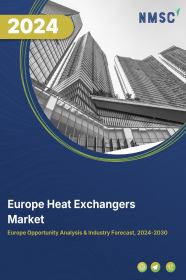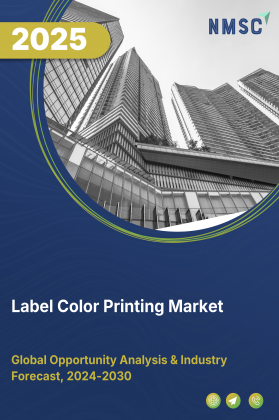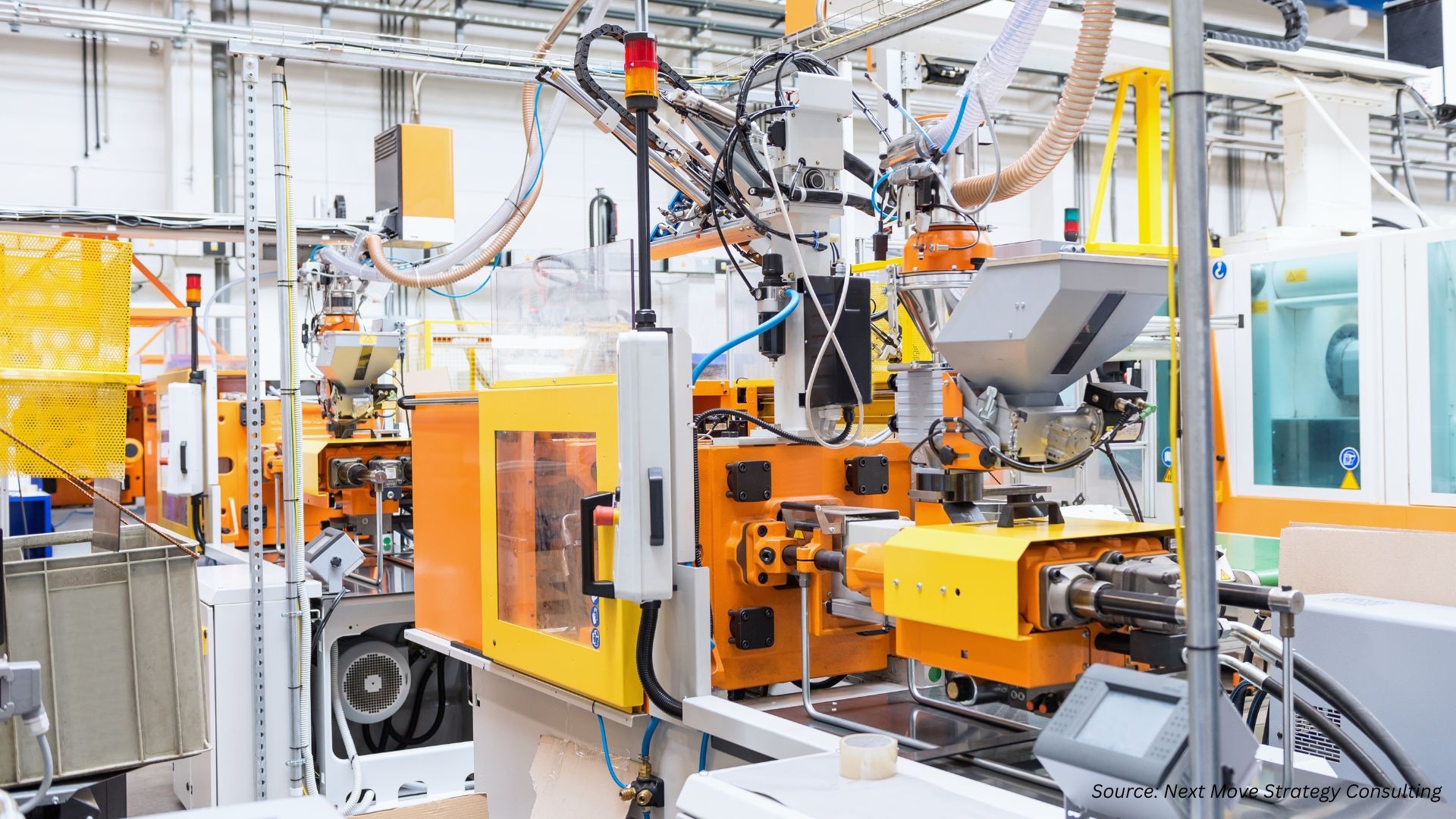
Europe Heat Exchangers Market by Type (Shell & Tube, Plate & Frame Heat Exchangers, Air Cooled, and Others), by Material (Metals, Alloys, and Brazing-CLAD), and by End User (Chemical, Energy, (HVACR), Food & Beverage, power, Pulp & Paper, and Other End User)– Opportunity Analysis and Industry Forecast, 2024–2030.
Industry: Construction & Manufacturing | Publish Date: 28-Aug-2025 | No of Pages: 303 | No. of Tables: 215 | No. of Figures: 140 | Format: PDF | Report Code : CM1524
Market Overview
The Europe Heat Exchangers Market size was valued at USD 3613.9 million in 2023, and is predicted to reach USD 5415.9 million by 2030, with a CAGR of 5.3% from 2024 to 2030.
Heat exchangers are sophisticated devices crafted to transfer heat from one fluid to another without direct fluid contact. They are widely deployed across industrial, commercial, and residential domains, including HVAC systems and refrigeration units, to effectively heat or cool fluids or air. These devices function by permitting heat to traverse through a barrier, be it a solid wall or a series of plates or tubes.
Their utility spans various tasks, from heating water in boilers to cooling air in air conditioning systems. Heat exchangers come in a myriad of designs customized to specific needs, ranging from basic radiator coils to intricate systems employed in chemical processing plants and power generation facilities.
They serve pivotal roles across multiple industries and applications, regulating air temperature in buildings, aiding steam production in power plants, managing temperatures during chemical reactions, and facilitating food processing, among other functions. Moreover, they are vital components in automotive cooling systems and boast extensive applications in aerospace, marine, and wastewater treatment sectors, playing a significant role in ensuring efficient thermal management and energy transfer.
Expanding Industrial and Urban Infrastructure Accelerates Adoption
The continued industrial expansion and rapid urbanization across Europe are major catalysts for the rising demand for heat exchangers. As European cities invest in modern infrastructure and smart urban developments, the need for reliable and energy-efficient HVAC systems intensifies. Heat exchangers serve as critical components in maintaining thermal efficiency within residential complexes, commercial spaces, public institutions, and transport systems.
Simultaneously, Europe's industrial base—including sectors such as chemical processing, automotive, food & beverage, metal processing, and power generation—is undergoing modernization. These industries require high-performance thermal management systems for process heating, cooling, and waste heat utilization. The consistent growth in these sectors fuels robust demand for advanced heat exchanger technologies across the continent.
Green Transition and Policy Push Driving Technological Integration
Europe's strong commitment to climate goals and decarbonization strategies is reshaping the energy and industrial landscape. Regulatory mandates promoting energy efficiency, carbon neutrality, and sustainability are encouraging the widespread integration of heat exchangers in various applications—from industrial processes to building energy systems.
The growing adoption of low-carbon technologies, energy-efficient equipment, and cleaner production methods relies heavily on heat exchangers to optimize energy use and reduce thermal losses. Government-backed programs and EU-wide directives focusing on green transitions are reinforcing the role of heat exchangers in achieving sector-wide environmental compliance and energy conservation targets.
High Capital Costs and Competition from Emerging Technologies
While the market outlook remains positive, the adoption of heat exchangers in Europe is hindered by high initial investment requirements. Capital-intensive procurement, coupled with complex installation and maintenance, can be a barrier for small and medium-sized businesses, particularly in sectors with limited operational budgets. This cost sensitivity may delay upgrades or discourage adoption altogether.
Furthermore, the emergence of alternative thermal management technologies is creating competitive pressure. Innovations such as phase change materials, compact heat storage systems, and advanced thermal interface solutions offer novel performance attributes, including lower space requirements and simplified system integration. These evolving solutions may attract customers looking for tailored or low-maintenance options, challenging the traditional dominance of conventional heat exchangers in specific applications.
Strategic Role in Energy Transition and Circular Economy Initiatives
The Europe heat exchangers market is poised for growth through its alignment with continental energy transition efforts and the circular economy agenda. As countries intensify efforts to reduce reliance on fossil fuels and improve energy recovery, heat exchangers are becoming indispensable in renewable energy infrastructure—facilitating efficient thermal transfer in solar thermal plants, biomass systems, and geothermal installations.
Additionally, their integration into waste heat recovery and district energy networks supports Europe’s ambitions for sustainable urban development and energy reuse. The rise of near-zero energy buildings and climate-resilient industrial zones presents fresh avenues for product deployment.
With national and EU-level policies offering incentives, subsidies, and supportive frameworks, manufacturers and solution providers that innovate toward low-emission, energy-optimized heat exchanger systems stand to benefit significantly from the region’s accelerating transition to a low-carbon economy.
Germany holds the dominant market share in the European Market
Germany holds the dominant market share in the heat exchangers market due to several factors. Firstly, Germany is known for its strong industrial base and advanced manufacturing capabilities, allowing it to produce high-quality heat exchangers that meet stringent industry standards.
Secondly, the country has a robust research and development infrastructure, fostering innovation in heat exchanger technologies and enabling continuous improvements in efficiency and performance. Thirdly, Germany's emphasis on energy efficiency and environmental sustainability drives the adoption of heat exchangers across various sectors, including automotive, aerospace, manufacturing, and renewable energy.
Additionally, the country's well-developed infrastructure and favorable government policies support the growth of the heat exchangers industry by encouraging investments and promoting market expansion. Overall, Germany's combination of technological expertise, innovation, and supportive policies positions it as a leader in the global heat exchangers market.
Russia is Expected to Show Steady Growth in the European Market
Russia is expected to show steady growth in the heat exchangers market due to several factors. Firstly, the country's expanding industrial sector, particularly in sectors such as oil and gas, chemical processing, and power generation, drives the demand for heat exchangers for various applications including heat recovery, thermal management, and process heating.
Secondly, Russia's focus on modernizing its infrastructure and improving energy efficiency creates opportunities for the adoption of heat exchangers in HVAC systems, industrial processes, and renewable energy projects. Thirdly, government initiatives aimed at promoting energy efficiency and reducing environmental impact further stimulate the demand for heat exchangers across different industries.
Additionally, Russia's strategic geographic location and its role as a major energy exporter contribute to the growth of the heat exchangers market as it fuels investments in energy-related infrastructure projects. Overall, these factors collectively support the anticipated steady growth of the heat exchangers market in Russia.
Competitive Landscape
Several market players operating in the Europe heat exchangers market include Alfa Laval AB, Danfoss A/S, Kelvion Holding GmbH, GEA Group AG, SWEP International AB, SPX FLOW, Inc., API Heat Transfer, Inc., LU-VE Group S.p.A., AKG Thermotechnik GmbH, FUNKE Warmeaustauscher Apparatebau GmbH, Thermowave GmbH, HRS Heat Exchangers Ltd., Hisaka Works, Ltd., Vahterus Oy, Guntner GmbH And Co. KG, Modine Manufacturing Company, Peter Huber Kaltemaschinenbau SE, Tranter Inc., Vestas Aircoil A/S, BORSIG Process Heat Exchanger GmbH, among others. These companies are adopting various strategies such as product launches to remain dominant in the heat exchangers market.
Key Market Segments
By Type
-
Shell & Tube
-
Fixed Tube Heat Exchangers
-
U-Tube Heat Exchangers
-
Floating Head Heat Exchangers
-
Other Shell & Tube Heat Exchangers
-
-
Plate & Frame Heat Exchangers
-
Gasketed Plate & Frame Heat Exchangers
-
Welded Plate & Frame Heat Exchangers
-
Brazed Plate & Frame Heat Exchangers
-
Other Plate & Frame Heat Exchangers
-
-
Air Cooled
-
Forced Draft Heat Exchangers
-
Induced Draft Heat Exchangers
-
-
Others
By Materials
-
Metals
-
Steel
-
Copper
-
Aluminum
-
Titanium
-
Nickel
-
-
Alloys
-
Stainless steel
-
Copper alloys
-
Aluminum alloys
-
Other alloys
-
-
Brazing-CLAD
-
Copper brazing
-
Ni clad brazing
-
Phosphor copper brazing
-
Silver brazing
-
Other brazing clad
-
By End User
-
Chemicals
-
Base Chemicals
-
Intermediate Chemicals
-
Specialty Chemicals
-
-
Energy
-
Petrochemicals
-
Oil & Gas.
-
-
HVACR
-
District Heating & Cooling
-
Commercial Refrigeration
-
Air Conditioning
-
Industrial Refrigeration
-
-
Food & Beverages
-
Process Food
-
Dairy
-
Other Food & Beverages
-
-
Power
-
Renewable
-
Non-Renewable
-
-
Pulp & Paper
-
Other End User
By Country
-
UK
-
Germany
-
France
-
Italy
-
Spain
-
Denmark
-
Netherlands
-
Finland
-
Sweden
-
Norway
-
Russia
-
Rest of Europe
Key Players
-
Alfa Laval AB
-
Danfoss A/S
-
Kelvion Holding GmbH
-
GEA Group AG
-
SWEP International AB
-
SPX FLOW, Inc.
-
API Heat Transfer, Inc.
-
LU-VE Group S.p.A.
-
AKG Thermotechnik GmbH
-
FUNKE Warmeaustauscher Apparatebau GmbH
-
Thermowave GmbH
-
HRS Heat Exchangers Ltd.
-
Hisaka Works, Ltd.
-
Vahterus Oy
-
Guntner GmbH And Co. KG
-
Modine Manufacturing Company
-
Peter Huber Kaltemaschinenbau SE
-
Tranter Inc.
-
Vestas Aircoil A/S
-
BORSIG Process Heat Exchanger GmbH
REPORT SCOPE AND SEGMENTATION:
|
Parameters |
Details |
|
Market Size in 2023 |
USD 3613.9 Million |
|
Revenue Forecast in 2030 |
USD 5415.9 Million |
|
Growth Rate |
CAGR of 5.3% from 2024 to 2030 |
|
Analysis Period |
2023–2030 |
|
Base Year Considered |
2023 |
|
Forecast Period |
2024–2030 |
|
Market Size Estimation |
Million (USD) |
|
Growth Factors |
|
|
Countries Covered |
9 |
|
Companies Profiled |
20 |
|
Market Share |
Available for 10 companies |
|
Customization Scope |
Free customization (equivalent up to 80 working hours of analysts) after purchase. Addition or alteration to country, regional, and segment scope. |
|
Pricing and Purchase Options |
Avail customized purchase options to meet your exact research needs. |

















 Speak to Our Analyst
Speak to Our Analyst
























